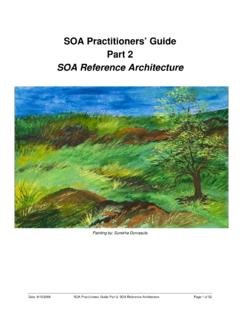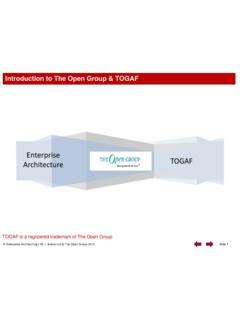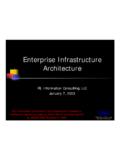Transcription of SOA BLUEPRINT – REFERENCE ARCHITECTURE VERSION 1
1 SOA BLUEPRINT REFERENCE ARCHITECTURE VERSION SOA Alliance Group of SOA Practitioners Abstract Service Oriented ARCHITECTURE (SOA) is the business operations strategy for leveraging information to meet organizational objectives such as growing revenue, increasing customer satisfaction and improving product quality. SOA is not a well traveled road and lacks many of the shared experiences, assets and patterns required for widespread and reliable adoption. Moreover, without a common language and industry blueprints, SOA may fail to deliver the promised benefits of intra and inter-enterprise services reuse and process interoperability instead adding more custom logic and increased complexity to IT A group of SOA Practitioners have agreed to come together under the SOA Alliance to provide leadership in the industry to address the challenges.
2 The SOA BLUEPRINT is envisioned as a multi-volume collection of publications that can act as a standard REFERENCE encyclopedia for all SOA stakeholders. This document, the SOA REFERENCE ARCHITECTURE , is an early asset created as part of the broader SOA BLUEPRINT initiative. It is intended to provide the end user / consumer perspective which hopefully will influence both the vendor community and the standards organizations. Keywords Service Oriented ARCHITECTURE , SOA, SOA Alliance Introduction Today, there is a lot of hype around SOA and it is expected to continue until the industry matures. SOA is not a well traveled road and has the potential for failing to deliver the promised benefits of intra and inter-enterprise services reuse and process interoperability.
3 Instead, it may add more custom logic and propagate the IT legacy. Following are some of the reasons for concern that SOA may not deliver on its promises. Every major vendor claims to have adopted SOA and have published their own view and REFERENCE ARCHITECTURE around SOA. Every major standards body has multiple working or expert groups attempting to define the SOA BLUEPRINT or SOA REFERENCE ARCHITECTURE from their point of view. Even though SOA is in the initial phases, there are not sufficient development and management tools. Enterprises are attempting to solve similar problems but without a forum for sharing best practices across the industry. Various product vendors, system integrators, analysts have all attempted to share these practices however, the information may have been lost in translation because of lack of common vocabulary across the industry.
4 These conditions add to the confusion resulting in delayed adoption of SOA. SOA REFERENCE ARCHITECTURE Definition The SOA REFERENCE ARCHITECTURE is an ideal Target State ARCHITECTURE for an Enterprise or Line-Of-Business (LOB). Some also refer to this as the Future State or Future Vision of the Enterprise. The objective of the SOA BLUEPRINT is to provide enterprises the ability to build a Roadmap to start the journey to the Target State from their Current State. SOA REFERENCE ARCHITECTURE Approach One needs to understand two aspects of SOA to be able to develop the REFERENCE ARCHITECTURE : The three SOA Foundation components that drive Service Oriented ARCHITECTURE Enterprise SOA Maturity Model SOA Foundation The SOA Foundation components are illustrated in the figure below.
5 Figure 1 -- SOA Foundation The three foundation components are: Business ARCHITECTURE : Based on the business strategy, objectives, priorities and processes. Getting this right is essential for the successful implementation of SOA. One of the major benefits of SOA is reuse of business processes which provides higher ROI than the potential reuse of Infrastructure or Data components. This also includes the business processes as well as implementation of business applications. Infrastructure ARCHITECTURE : This is the engine that enables SOA and should address all the aspects of the infrastructure from networks, servers, data centers, firewalls, to application infrastructure, security, monitoring, middleware, etc.
6 Information and Data ARCHITECTURE : This deals with identifying the Key Performance Indicators and the information needs that drive the enterprise. Data ARCHITECTURE deals with the logical and physical modeling of the data as well as data manipulation and data quality. The SOA REFERENCE ARCHITECTURE covers each of these areas at length by providing approaches, requirements and design patterns wherever possible. Enterprise SOA Maturity Model The SOA maturity model helps enterprises develop a roadmap to achieve their Target State. Figure 2 Enterprise SOA Maturity Model The above diagram illustrated the enterprise SOA maturity model which can be classified into following stages. Web Application Development Stage: Provide browser based business solutions to both internal and external users.
7 This could be in the form of rolling out web based CRM, ERP or custom applications. In addition, IT organizations would typically deploy enterprise services such as content management, search, instant messaging, discussion forums, white board, etc. Develop Composite Applications: Access and provide aggregated information from multiple sources to the users, initially internally and later externally. This generally requires focus on improving data quality. Automate Business Process: This is the stage where the applications, data and infrastructure work with the user to provide the capability that need to perform their roles effectively in the organizations.
8 It empowers them by providing the right information at the right time. It is this stage where the enterprise matures and is enabled to achieve higher ROI by consolidating multiple business systems to a single system. This also requires business organizations to transform from their current state to the target state of end-to-end business process management, rather than point solutions. SOA REFERENCE ARCHITECTURE The following diagram illustrates the SOA REFERENCE ARCHITECTURE which is categorized into three tiers Web Application Tier, Service Tier and Application Tier. Figure 3 -- SOA REFERENCE ARCHITECTURE It is not necessary for IT organizations to deploy the entire infrastructure identified in this SOA REFERENCE ARCHITECTURE .
9 One of the SOA Best Practices is to invest in the infrastructure only whenever it is required to provide business solutions. Following is a brief description of each of the components: Web Application Tier The primary requirement for this tier is that all the business systems / solutions should be accessible from any (supported) browser. To a large extent, this is the user interface or the presentation tier and shall contain business logic for components such as enterprise infrastructure services, applications, etc. Packaged Applications Typically enterprises tend to go out in the market and license the best of the breed packaged applications that meet their businesses requirements. IT organizations, either themselves or by leveraging the System Integrators, then tailor the packaged applications to meet their needs.
10 Examples of such packaged applications are Customer Relationship Management (Call Center, Sales Force Automation, Campaign Management, Order Management, etc.), Enterprise Resource Planning (Human Resources, Finance, Contract Management, etc.) or other industry-specific large application suites. Most of the packaged applications are now internet protocol based which means that users can access many of its functions using any (supported) browser. Some of the latest versions of the packaged application have provided the capability to expose a limited set of functions as discrete callable services or externally controlled business processes. Some of the best practices for leveraging packaged applications include: Identify and implement the best of the breed packaged applications that meet the business requirement.









